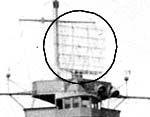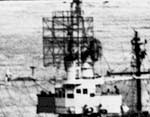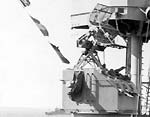·豬鋼鬃·
摘抄學習軍政知識
正文
簡介:
企業號(Enterprise CV-6)是第7艘以企業命名的艦隻,她是約克城級航母中的第2艘,於1934年7月動工建造,1936年10月下水,1938年5月在東海岸開始服役,1939年4月轉入太平洋服役。
企業號綽號“大企(the Big E)”,幾乎參加了太平洋的所有重要戰役。大企是個幸運兒,在對手是崇尚武士道的日本人的情況下,能夠看到戰爭的結束本身就說明了這一點。
企業號在二戰中共獲20枚戰役之星勳章,她於1947年退出現役。第8艘以企業號命名的艦隻就是1959年的第一艘核動力航母,企業號的戰鬥精神與其名字一樣將一直延續下去。
美國“企業”(Enterprise CVN-65)號核動力航空母艦為世界上第一艘核動力航空母艦。1964年,“企業”號進行了史無前例的環球航行,途中無需加油和再補給,曆時64天,總航程3萬多海裏,充分顯示了核動力的巨大續航力。
The Most Decorated Ship of the Second World War
二次大戰中最輝煌的戰艦
Source: United States Naval Institute
來源:美國海軍研究協會
"The carrier that fought the most through the entire war..."
-----Dedicatory Plaque, Enterprise Tower, U.S. Naval Academy
“這艘航母幾乎參加了戰爭中的全部戰役”
-----奉獻銘記,企業號艦塔,美國海軍學院
Enterprise entered World War II on the morning of December 7, 1941, when her scout planes encountered the Japanese squadrons attacking Pearl Harbor. Not until May 14, 1945, when a Kamikaze attack off Kyushu, Japan, left a gaping hole in her flight deck, was she forced to leave the war.
Of the more than twenty major actions of the Pacific War, Enterprise engaged in all but two. Her planes and guns downed 911 enemy planes; her bombers sank 71 ships, and damaged or destroyed 192 more. Her presence inspired both pride and fear: pride in her still unmatched combat record, and fear in the knowledge that Enterprise and hard fighting were never far apart.
The most decorated ship of the Second World War, Enterprise changed the very course of a war she seemed to have been expressly created for.
1941年12月7日早上當企業號的偵察機發現日軍飛機偷襲珍珠港時,她開始真正進入二戰。直到1945年5月14日,一架從日本九州起飛的自殺轟炸機在她的甲板上炸開一個大洞後,她才被迫退出戰爭。
太平洋戰爭的二十幾次重大戰鬥,“企業”號隻錯過了其中的兩次。她的飛機和艦炮擊落了911架敵機;她的炸彈擊沉了71艘敵艦,擊傷超過敵艦超過192艘。她的傳奇是驕傲而又恐怖的。驕傲是因為她無人可及的作戰紀錄,恐怖是因為她的殘酷戰鬥從未間斷過。
“企業”號,這艘二戰中最輝煌的戰艦,改變了這場戰爭的進程。
原文來源鏈接:http://www.cv6.org/
企業號(Enterprise CV-6)是第7艘以企業命名的艦隻,她是約克城級航母中的第2艘,於1934年7月動工建造,1936年10月下水,1938年5月在東海岸開始服役,1939年4月轉入太平洋服役。
企業號綽號“大企(the Big E)”,幾乎參加了太平洋的所有重要戰役。大企是個幸運兒,在對手是崇尚武士道的日本人的情況下,能夠看到戰爭的結束本身就說明了這一點。
企業號在二戰中共獲20枚戰役之星勳章,她於1947年退出現役。第8艘以企業號命名的艦隻就是1959年的第一艘核動力航母,企業號的戰鬥精神與其名字一樣將一直延續下去。
美國“企業”(Enterprise CVN-65)號核動力航空母艦為世界上第一艘核動力航空母艦。1964年,“企業”號進行了史無前例的環球航行,途中無需加油和再補給,曆時64天,總航程3萬多海裏,充分顯示了核動力的巨大續航力。
The Most Decorated Ship of the Second World War
二次大戰中最輝煌的戰艦
Source: United States Naval Institute
來源:美國海軍研究協會
"The carrier that fought the most through the entire war..."
-----Dedicatory Plaque, Enterprise Tower, U.S. Naval Academy
“這艘航母幾乎參加了戰爭中的全部戰役”
-----奉獻銘記,企業號艦塔,美國海軍學院
Enterprise entered World War II on the morning of December 7, 1941, when her scout planes encountered the Japanese squadrons attacking Pearl Harbor. Not until May 14, 1945, when a Kamikaze attack off Kyushu, Japan, left a gaping hole in her flight deck, was she forced to leave the war.
Of the more than twenty major actions of the Pacific War, Enterprise engaged in all but two. Her planes and guns downed 911 enemy planes; her bombers sank 71 ships, and damaged or destroyed 192 more. Her presence inspired both pride and fear: pride in her still unmatched combat record, and fear in the knowledge that Enterprise and hard fighting were never far apart.
The most decorated ship of the Second World War, Enterprise changed the very course of a war she seemed to have been expressly created for.
1941年12月7日早上當企業號的偵察機發現日軍飛機偷襲珍珠港時,她開始真正進入二戰。直到1945年5月14日,一架從日本九州起飛的自殺轟炸機在她的甲板上炸開一個大洞後,她才被迫退出戰爭。
太平洋戰爭的二十幾次重大戰鬥,“企業”號隻錯過了其中的兩次。她的飛機和艦炮擊落了911架敵機;她的炸彈擊沉了71艘敵艦,擊傷超過敵艦超過192艘。她的傳奇是驕傲而又恐怖的。驕傲是因為她無人可及的作戰紀錄,恐怖是因為她的殘酷戰鬥從未間斷過。
“企業”號,這艘二戰中最輝煌的戰艦,改變了這場戰爭的進程。
| ||||
| ||||
| ||||
| ||||
| ||||
| ||||
| ||||
| ||||
| ||||
原文來源鏈接:http://www.cv6.org/
評論
目前還沒有任何評論
登錄後才可評論.

























